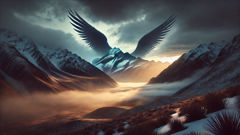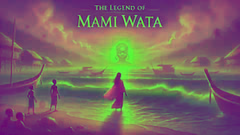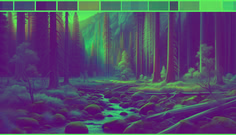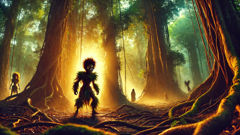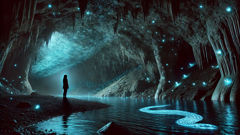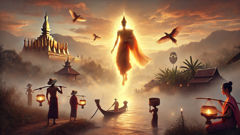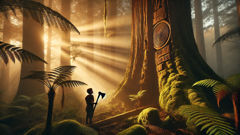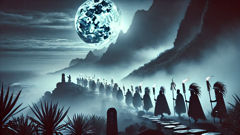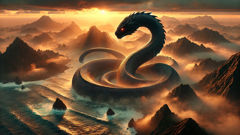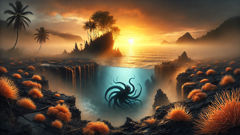Introduction
On the flanks of the Southern Alps where cloud sweeps like shrouds over knife-edged ridges and rivers cut silver through gorges, the Pouakai lived in story before it ever lived in sight. It belonged to the high places — the raw, wind-carved summits where human hands touched sparse tussock and stone, and where the world narrowed to the clean, merciless geometry of sky and peak. Maori told of an enormous bird with a hooked beak and wings that blocked out the sun, a predator that stalked shepherds and hunters and did not shrink from men. Across generations, as families moved from valley to valley, the name of the Pouakai was folded into lullabies and warnings: keep to the huts at dusk, blare your horns at ridgelines, leave a carved feather at the marae and ask for protection. Yet the Pouakai was more than a caution. It carried the gravity of an idea — the mountain's appetite, the unpredictable cruelty of nature, and the necessity of respect. This retelling gathers those threads and follows them through recorded sightings, oral memory, and the hard geography of New Zealand's South Island. I trace where the tale began, how it evolved as settlers and shepherds encountered its shadow, and what the Pouakai means now: an emblem of a landscape both beautiful and unforgiving, and a mirror of a people’s way of making sense of wild things that don't bend to human order.
Origins, Sightings, and the Shape of Fear
The Pouakai belongs to the margins where maps blur and the human voice grows careful. Maori storytellers from different iwi (tribes) placed the bird in various pockets of the South Island — in the headwaters of braided rivers, in narrow passes where muttonbirds nested, and along scree slopes that gave way without warning. Language carries the Pouakai in many forms: sometimes as a monstrous eagle, sometimes as spirit-shape, sometimes as a caution to those who would take more than the land could yield. The details shift with geography; the core remains the same. It is a mountain predator, a being of scale and hunger, a presence that moves the light and steals the safe stillness of a valley. European settlers learned the story from Maori and through their own terrifying experiences. When flocks of sheep were found stripped of flesh high on alpine ledges, when a plucky shepherd vanished from an otherwise trackless slope, whispers hardened into newspapers and then into the pages of county record books. An 1870s ledger from a Canterbury run notes 'a great bird of prey, larger than any hawk, seen by shepherds above the head of the Rakaia', while a station diary from further south describes 'a shadow like a sail, something heavy and quick across the ridge.' These are small things — a line in a ledger, a scratched note — but repetition gives them weight. Sightings cluster around weather patterns and seasons. In the storms that hound the spine of the island, visibility can drop to a hand's reach and birds driven by hunger can stray into human spaces. Hunters recounted the Pouakai as opportunistic: it took lambs, calves, even strayed ponies; it was bold enough, they said, to snatch a man who had paused, breath fogging in the wind, to lift himself up by a boulder. To modern ears, populated by biology, the Pouakai invites comparison with the haasts eagle, an extinct raptor once native to New Zealand, known to have preyed on moa and possibly capable of taking large animals. The haast's existence offers a bridge between myth and palaeontology; its wingspan and power make it a plausible inspiration for stories of monstrous birds. But the Pouakai is not merely a memory of a bird — it's a living thing in the web of human meaning. In some versions, it is a taniwha-like spirit, an embodiment of landscape anger. In others, it is a cautionary emblem, a way to teach children that mountains are not playgrounds. Those who knew the high country best combined practical steps with ritual. Carvings and offerings at huts, vocal calls at dusk, and the hanging of talismans were as important as bellows and shotgun cartridges. The bird's hungry mythological teeth bit into daily life: sheep runs were planned with the shadow of the Pouakai in mind; shepherds kept lights and dogs and gabbed together at night, exchanging gossip that braided fact and fear. Memory is a living thing; migration and land use changed the rhythm of sighting. As more valleys were fenced, as predators such as dogs and stoats reshaped the ecology, the contexts that produced Pouakai stories shifted. Some versions softened into allegory. A shepherd's account passed down to grandchildren recast a desperate winter as a bout with the bird; what once might have been a mountain bear or hawk became the Pouakai because the larger story fit the edges of human fear. Yet even as contexts changed, the Pouakai persisted in newspapers and in the imaginations of tourists who read of 'the giant bird of the South'. In the twentieth century, hunters and naturalists wrote of 'moth-eaten lambs' and 'teeth marks inconsistent with canines', and their speculation sent ripples through small communities. Were those the marks of a single predator? Of a pack? Or of a myth-making human mind seeking patterns in loss? The bird's form adapted to each teller. Sometimes it was given human cunning — an intelligence that scoffed at traps and moved in circlets above unwary men. Sometimes it was a force of nature — indifferent, terrible, beautiful. The land itself makes a character in these stories: the sharp weather, the high winds that can lift and tumble the living, and the loneliness of alpine stations create fertile ground for tales. When a hut door thumps in a gale and a dog refuses the path, the Pouakai sits in the margin between explanation and imagination. Yet even sceptics must reckon with clusters of consistent detail. Multiple accounts name similar wing patterns, a croak like a falling log, talons that scraped stone. The motif of stolen people appears in a few sobering entries, where those taken were never seen again. It is hard to separate the myth's kernel from the human habit of storytelling; perhaps the Pouakai is a lattice of both — the imprint of an extinct raptor amplified by cultural practice and by the immensity of alpine weather. Archaeologists and natural historians have argued that giant raptors, large avian predators, and human hunters coexisted at different times in Aotearoa, and that oral tradition can conserve natural memory in ways written records sometimes cannot. The Pouakai sits at this crossroads, a creature translated across centuries: an animal in the bone and feather sense, a moral in the telling sense, and an emblem in the imagining sense. When modern researchers interview elders about the bird, they encounter more than a catalog of sightings. They find instructions about place and conduct, woven into memory as practical knowledge. The Pouakai stories direct people away from unstable cliffs, away from times of storm, and toward the huts where community protects the lone traveler. There is tenderness in the telling: the legend teaches preservation of life through respect for the mountain's undisclosed orders. The story, then, evolves as these needs evolve. A century ago it warned shepherds; now it prompts hikers to respect closures and alert families to the fragility of high country life. As much as it reflects loss — of animals, of lives, of ecosystems — it also holds an instruction: to learn the land's language before crossing it.
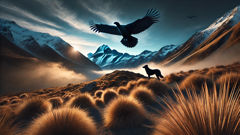
Hunts, Heroes, and the Bird's Last Echo
Stories of pursuit and attempted slaying gather like weather around the Pouakai. From the 19th-century pastoral papers to the whispered recollections at marae gatherings, tales pivot on a single question: can a human meet the bird and survive? The answers vary, and the variation reveals human needs — to explain the inexplicable, to claim mastery over fear, and to make a ritual of courage. One of the most repeated tales tells of a man named Hemi (a common name rendered in many tellings), a station hand who watched with sorrow as lambs vanished from his run. Hemi's family had seen the marks; his hutmates found feathers too large for any hawk they'd known. He swore to find the creature. This is how many versions go: a poor man with a sense of duty, a gun ill-suited to the heights, a dog that refuses to leave the mouth of the valley. The hunt begins at first light, when the mountain breath is thin and voices sound like stones. Hemi climbs with rope and prayer, following tracks that peter out among scree and lichen. At noon he glimpses a nest — not a simple bird's cup but a grotesque banquet of bone and wool and leather. In the branches of a dead alpine tree, among curled feathers like burnt leaves, he senses eyes. The encounter in the story is a dance of misread moments: the bird stoops; Hemi fires; the shot roars into the narrow place and seems to rebound; the Pouakai dives and yet is not found. In some tellings, Hemi returns crippled but alive; in others he is taken and the last sound his friends hear is a terrible caw rolled into thunder. These narratives serve moral purposes as much as they narrate events. They ask what price is right to pay for confronting monstrous forces, and how community binds itself together through shared risk. In certain iwi retellings, the bird is not slain by physical violence but by karakia (prayer) and the appeasement of a wronged spirit. A tohunga (spiritual expert) performs rites, leaves offerings at the bird's favored ledge, and sings a lament into the night; the Pouakai ceases to devastate the flocks, not because it was killed but because it was acknowledged and its hunger was given a place. This is a version of the story that emphasizes relationship over conquest, showing a worldview where humans are not destined to dominate the wild but to live with and honor it. European-settler narratives often skew toward the hunt and its triumph. Local newspapers in the early 20th century reported knuckles-gnashing attempts to trap the bird: nets stretched over passes, baits of salted carcass hung from poles, and teams of men waiting with guns and ropes. Sometimes these hunts caught something — an enormous eagle or a great hawk — and the carcass was displayed as prize and proof. Other times the hunting party returned with only the sense of emptiness. Those empty returns fed the legend: the Pouakai, if it existed, was cunning; it could outwit a pack of men and hide among cloud banks. Over time, stories of heroism gained theatrical flourish. A folk hero emerges in many accounts: a station owner who hires trackers, an old Maori woman who unearths the creature's secret nesting place, or a young shepherd who sacrifices himself to divert the bird from town. These figures consolidate community ideals: self-sacrifice, cunning, and respect for the rules of the mountain. The tale of the young shepherd who lures the Pouakai toward a cliff, only to have the bird misjudge and plummet, persists in some valleys. Those retellings are ambivalent: they close the threat but at terrible cost, reminding listeners that violence begets violence and that wins are often pyrrhic. As modern science expanded, so did the frameworks for explaining events. Paleontological comparisons to the haasts eagle offered a plausible ancestor for tales of giant birds, but they did not dissolve the legend. Instead, they gave it another layer: the idea that the modern world has lost something immense and uncanny. Conservationists, naturalists, and iwi leaders have used the Pouakai legend as a teaching tool — a way to speak about extinction, habitat change, and human impact. The bird becomes a symbol for species that vanished because ecosystems changed too quickly. This use of legend is not new but rather a continuation of oral tradition: stories always teach practical things. The Pouakai now teaches stewardship. The narrative of hunt and conquest collides with that of mourning and reparation. In several contemporary retellings, the bird is anthropomorphized into a guardian who becomes enraged when the mountain is violated — when rivers are channelled, when native trees are cleared, when introduced predators decimate the birds that once fed the big raptors. This shift reframes the Pouakai from a simple monster into a barometer of ecological health. Poets and artists in New Zealand have used the Pouakai's silhouette as an emblem in campaigns: its outstretched wings appear on posters urging protection of alpine habitats, and its haunting cry is evoked in elegies for lost species. At visitor centers and in guidebooks, the story is told with a measured voice: the Pouakai may never have been a single, identifiable animal, but it keeps showing up because humans need it to. It is the way we speak about unspeakable things — the sudden vanishing, the ambiguous trail, the blank ledge where a man once stood. The legend's persistence rests on its adaptability. When modern hikers leave offerings in the form of a carved feather or a respectfully placed stone, they repeat gestures ancient in their intent: to acknowledge that the mountains demand humility. When scientists walk cautious transects across fragile alpine zones, they enact a different kind of respect, one founded in evidence-gathering but informed by the cultural memory that the Pouakai carries. The legend thus becomes a bridge. It moves from being a tale used to frighten children into staying near the hut, into becoming part of an ethical conversation about landscape, memory, and responsibility. That ethical conversation also asks difficult questions about representation. Who owns the Pouakai story? How do we tell it without flattening iwi-specific meanings into a tourist-salable myth? In many communities, elders remind younger storytellers to credit the places and people who first held the narrative. Museums and archives include the Pouakai in exhibits, but always with the caveat that a story nested in living tradition cannot be owned in the way an object can. It is kept alive by retelling, by adapted rituals, and by the landscape itself, which continues to speak in weather and stone. As the century turns and climate changes reshape alpine grazing and snowline, the Pouakai legends will likely continue to shift. Perhaps the bird will become an icon for recovered species, or perhaps it will stay as an emblem of what was lost. In either case, the story shows how human communities negotiate fear and wonder. The Pouakai's wings cut through time as surely as they might have once cut through air: both a threat and a reminder that in mountainous country, the best kind of knowledge is a mixture of careful observation, respect for place, and a readiness to be small in the face of greater forces.
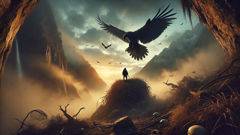
Conclusion
The Pouakai endures because it is a story that refuses to be reduced to a single truth. It is equal parts memory and metaphor: a record of a landscape's appetite, a vessel for grief over species that no longer exist, and a moral instrument teaching how to live in wild spaces. Its outlines are traced by wind, by the careful craft of elders, and by the fragile notations of settlers' diaries. Today the bird's shadow is used to teach stewardship of the Alps, to remind hikers and farmers that mountains are not props to be manipulated but living systems with their own rules. Communities who hold the Pouakai stories insist on the dignity of the telling: the bird should be spoken of with care, and its lessons passed on not as mere fright but as instruction. The legend moves forward as new generations adapt it, carving in language the same respect for place that sustained older tellers. If you stand on a ridge in the South Island at the precise hour when light goes thin and the air tastes of iron and rain, you might understand why the Pouakai entered human consciousness in the first place. It is the sense of being small in a big world, the recognition that not all dangers are rational and that sometimes the only wise response is humility. Perhaps that is the most enduring lesson the Pouakai leaves behind: that to listen deeply to the land is to acknowledge both its beauty and its dangers, and that stories — long after bones have crumbled — are the fragile cords by which people continue to learn how to live with the wild.

